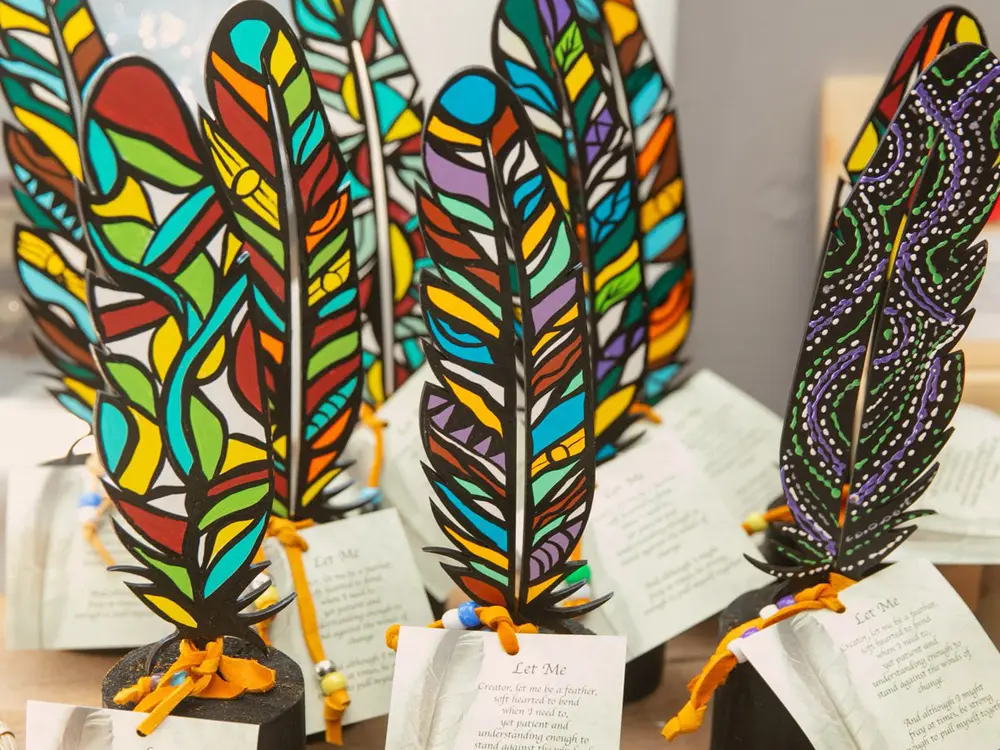Woodland Cultural Centre
The Woodland Cultural Centre brings the story of the Haudenosaunee people of the Eastern Woodlands to life by preserving and promoting language, history and culture. It also showcases the unique voices of Indigenous artists and honours Residential School survivors.
Established in 1972 after the closure of the Mohawk Institute Residential School, the centre has been collecting artifacts and celebrating Indigenous cultural heritage for nearly 50 years. Its collection is one of the largest Canadian facilities administered by the First Nations and includes everything from documents and sculptures to ethnographic materials.
Woodland Cultural Centre | Hamilton Halton Brant
How to get to Woodland Cultural Centre
Location: 184 Mohawk Street, Brantford
By car: The Woodland Cultural Centre is in the southeast corner of Brantford, which is best accessed via highway ON-403 or the Queen Elizabeth Way (QEW). Limited free guest parking is available in front of the building.
By transit: VIA Rail and GO Transit offer service to Brantford. Brantford Transit 1 bus travels from the train station to the centre.
Know before you go
The Woodland Cultural Centre is open Mondays through Fridays from 9:00 a.m. to 4:00 p.m. and Saturdays from 10:00 a.m. to 5:00 p.m.
It takes about 45 minutes to tour the museum and art galleries, so plan accordingly.
Note that the library is a private, non-lending library so items cannot be removed from the grounds.
Things to do at Woodland Cultural Centre
Discover more activities and experiences.
Explore the museum
Permanent and temporary museum exhibits tell the unique stories of the Iroquoian and Algonquian people in Southern Ontario from prehistoric to modern times.
Enjoy incredible art
Admire a rotating collection of compelling Indigenous art and themed exhibitions.
Join a tour
Gain a deeper understating from immersive self-guided tours and guided virtual tours or join a prearranged group tour.
Attend unique events
Check the calendar of upcoming events and educational programs.
Visit the gift shop
Purchase high-quality items made by small businesses and artisans from the Six Nations community and other Indigenous communities at the gift shop.
Articles and itineraries
Get ideas and inspiration for your next trip.

Interesting facts about Woodland Cultural Centre
Initially known as the Woodland Indian Cultural Education Centre, the Woodland Cultural Centre opened in 1972 under the direction of the Association of Iroquois and Allied Indians. Its mission was to collect research and artifacts for its library, archives and museum.
As the centre grew, it emphasized the arts and preserving Indigenous culture in Canada. In 1988, it was renamed the Woodland Cultural Centre.
The canoe in front of the museum was part of the 2015 InterNations exhibit. It demonstrates modes of transportation from an Indigenous perspective.
Accessibility Features
Accessible parking space
Accessible parking provides a place for people with disabilities to park and space to get in and out of their vehicles safely. It also provides access to the main accessible entrance and/or any other accessible entrances. Most users of wheelchairs need at least three feet of clearance to get in and out of their vehicles.
Automatic doors
Main entrance doors and other accessible entrances and exits are power assisted to allow easy access.
Ramps
An inclined plane that allows wheelchair users and others to access buildings and navigate between different levels.
Wide doorways and hallways
A sufficiently wide, hard-surfaced, unobstructed path to allow for easy travel.
Accessible washroom
At least one washroom stall larger than the others to accommodate adequate maneuvering space for mobility devices. They also include grab bars, transfer space, an accessible door latch, sink with knee clearance, and lever handles or automatic sensor faucets.
Service animals welcome
Can be identified by visual indicators (such as a vest or harness) or documentation from a regulated health professional confirming the animal is necessary due to a disability. In Ontario, service animals are allowed in all public spaces unless otherwise prohibited by law. A service animal is not a pet; it is trained to perform tasks to assist a person with a disability, such as guiding individuals with vision impairments, alerting to sounds for those with hearing impairments, assisting during seizures, retrieving items, or helping manage psychiatric and neurological disabilities. There are no restrictions on the type of animal used as a service animal in Ontario. If the animal is not easily identifiable, the person can provide documentation from a regulated health professional confirming the need for the service animal.
Support persons welcome
By law, you must allow a person with a disability to be accompanied by his or her support person while in the areas of your business that are open to the public. A support person is an individual hired or chosen by a person with a disability to provide services or assistance with communication, mobility, personal care, medical needs or with accessing goods, services or facilities. If you charge an admission fee at your business, you must let people know you charge an additional fee for a support person.
Last updated: September 25, 2025








